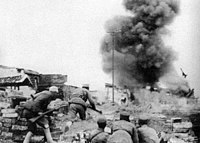Battle of Changde
This article may require copy editing for grammar, style, cohesion, tone, or spelling. (May 2010) |
| Battle of Changde | |||||||
|---|---|---|---|---|---|---|---|
| Part of World War II - the Second Sino-Japanese War | |||||||
| File:Changde prisoner.jpg A captured Japanese soldier crouches before his Chinese captors at Changde | |||||||
| |||||||
| Belligerents | |||||||
|
|
| ||||||
| Strength | |||||||
| 100,000 | 100,000 | ||||||
| Casualties and losses | |||||||
|
50,000 300,000 civilians | 40,000 | ||||||
The Battle of Changde (simplified Chinese: 常德会战; traditional Chinese: 常德會戰; pinyin: Chángdé Huìzhàn) was a major engagement in the Second Sino-Japanese War in and around the Chinese city of Changde in the province of Hunan. During the battle, Japan utilised extensive biological and chemical weapons. The purpose of the Japanese offensive was not to hold the city, but to maintain pressure on the Chinese National Revolutionary Army "in order to destroy their main units, to deny them the time needed for recuperation, regrouping, and retraining, and to make sure that no Chinese troops could be spared for the Burma front." As a result, the Japanese Army won the battle, but decided to abandon the city a month after defeating the Chinese forces.[2]
Western sources report the battle as being a Chinese victory.[3][4][5][6][7]
Battle

On November 2, 1943, the Imperial Japanese Army (IJA) invaded and occupied the undefended city of Changde. On November 18, 9,000 troops from the 57th Division of the Chinese National Revolutionary Army (NRA) arrived and retook the city. The IJA then counterattacked, and the 57th held out for 16 days until December 3, when the 100 remaining soldiers escaped the Japanese siege and linked up with reinforcements who retook the city on December 9. Reinforcements arrived from both sides and fighting continued until December 20, when the NRA suspended efforts to control the city and retreated from the battle front. The IJA secured Changde, but chose to withdraw the next month, in January 22, 1944, after which Chinese forces returned to occupy the city.[8]
Reporter Israel Epstein witnessed and reported on the battle. Witold Urbanowicz, a Polish pilot fighting in China in 1943, had seen the city just after the battle. According to Urbanowicz, nearly 300,000 civilians died in Changde.[citation needed]
Biochemical attacks
During the Khabarovsk War Crimes Trials, some witnesses such as Major General Kiyashi Kawashima, testified that, as early as November 1941, about 40 members of unit 731 airdropped fleas contaminated with bubonic plague on Changde and that these operations caused outbreaks of plague epidemics. Overall, 7,643 Chinese died in 1942 following this contamination.[9] Some Japanese soldiers (notably Yoshio Shinozuka) also admitted to have spread Bubonic plague within a 36-km radius around the city. However, the Japanese action did not achieve its objective, as the Chinese defenders put up additional resistance.
In the intense fighting around Changde, Japanese forces could not push through the heavy Chinese resistance, and decided to fire poison gas artillery shells into the city. The shells possibly contained mustard gas or lewisite. This action was undertaken by Unit 516 of the Japanese Army during the Second Sino-Japanese War. This and other units used assorted types of chemicals in liquid or gaseous form, including mustard gas, lewisite, cyanic acid gas and phosgene in experimental and some operational uses during hostile actions against China. This was effective in spreading fear, terror and death to devastating effect against both humans and livestock.
Gallery
-
NRA soldiers
-
Japanese prisoners at Changde
-
Japanese prisoner with Chinese soldiers guarding him at Changde
References
This article needs additional citations for verification. (May 2010) |
- ^ LIFE Feb 21, 1944
- ^ ed. Hsiung, James C. and Steven I. Levine "China's Bitter Victory: The War with Japan 1937-1945", pp.161
- ^ Simon Newton Dexter North, Francis Graham Wickware, Albert Bushnell Hart (1944). The American year book: Volume 29. T. Nelson & Sons. p. 94. Retrieved 2010-06-28.
{{cite book}}: CS1 maint: multiple names: authors list (link) - ^ George Creel (1949). Russia's race for Asia. Bobbs-Merrill Co. p. 214. Retrieved 2010-06-28.
- ^ Free world, Volume 8. Free World, Inc. 1944. p. 309. Retrieved 2010-06-28.
- ^ Philip J. Jaffe (1943). Amerasia, Volume 7. Amerasia, inc. Retrieved 2010-06-28.
- ^ LIFE Feb 21, 1944
- ^ ed. Hsiung, James C. and Steven I. Levine "China's Bitter Victory: The War with Japan 1937-1945", pp.161
- ^ Vet refuses to take Unit 731 to his grave, Japan Times, 2004
Sources
- Hsu Long-hsuen and Chang Ming-kai, History of The Sino-Japanese War (1937–1945) 2nd Ed., 1971. Translated by Wen Ha-hsiung, Chung Wu Publishing; 33, 140th Lane, Tung-hwa Street, Taipei, Taiwan Republic of China. Pg. 412-416 Map 38
- Daniel Barenblatt, A plague upon Humanity, HarperCollns, 2004, pp. 220–221
External links
- Axis History Forum Index; WW2 in the Pacific & Asia; Battle of Changde Order of Battle and Map, Photos from Changde (常德) War Memorial
- RESISTANCE WARS; Campaign of E-Xi, Battle Of Changde

